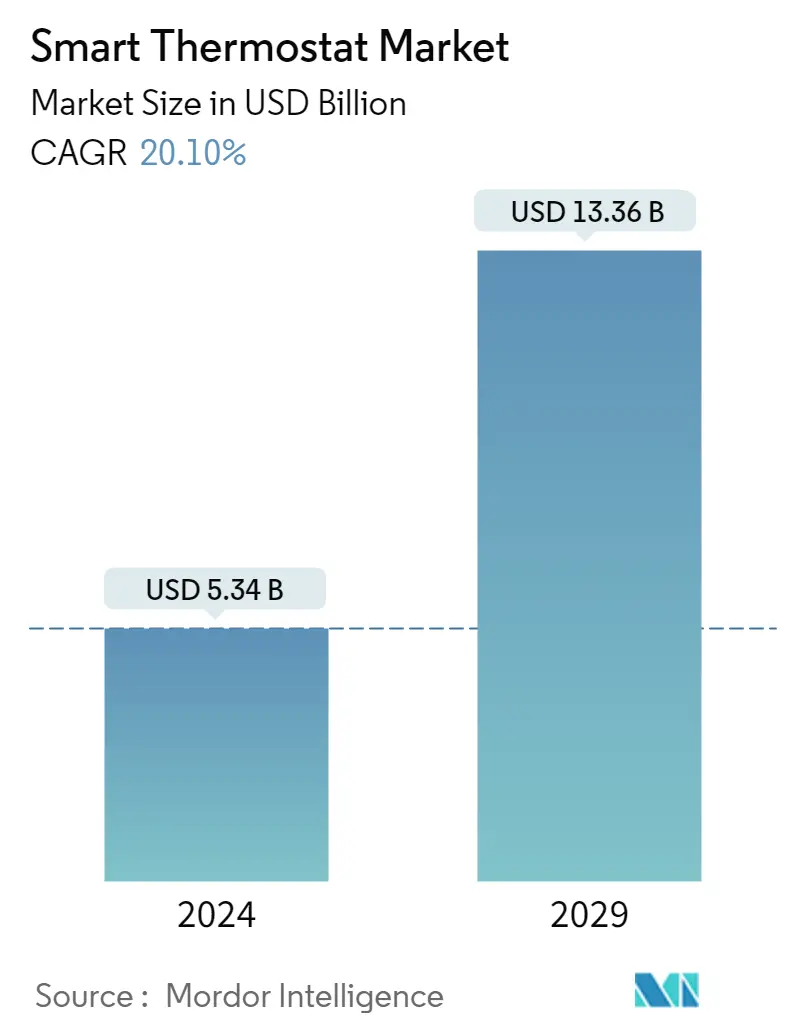Market Size of Smart Thermostat Industry

| Study Period | 2019 - 2029 |
| Market Size (2024) | USD 5.34 Billion |
| Market Size (2029) | USD 13.36 Billion |
| CAGR (2024 - 2029) | 20.10 % |
| Fastest Growing Market | Asia Pacific |
| Largest Market | North America |
| Market Concentration | High |
Major Players
*Disclaimer: Major Players sorted in no particular order |
Smart Thermostat Market Analysis
The Smart Thermostat Market size is estimated at USD 5.34 billion in 2024, and is expected to reach USD 13.36 billion by 2029, growing at a CAGR of 20.10% during the forecast period (2024-2029).
Lighting and other household appliances consume a considerable amount of energy, and presently, there is a dire need to use these energy resources efficiently. Therefore, governments are emphasizing the use of smart devices in homes.
- The increasing adoption of smart homes across the globe, the occurrence of the COVID-19 pandemic, the emergence of IoT-enabled HVAC systems, the surging adoption of smart home voice assistants, and government regulations pertaining to increasing the energy efficiency of buildings are some of the factors propelling the demand for Smart Thermostat Market over the next couple of years.
- Moreover, the critical factors driving the need for smart thermostats are convenience, energy conservation, energy tracking, and the need for an increase in potential savings. Also, the BYOT (Bring-your-own-Technology) trend is expected to stimulate the growth of the market over the forecast period. Consumers have independently begun purchasing smart Wi-Fi-enabled thermostats capable of receiving demand response control signals.
- Additionally, with a Wi-Fi connection and smart thermostats, virtual assistants, like Amazon Alexa, or Google Assistant, are increasingly being used to control and monitor the home temperature, program schedules, or manage the Air conditioning.
- A wireless network is the most widely used connectivity technology in smart thermostats as it helps the customers to bring down the maintenance and installation costs, along with providing higher scalability and flexibility, and enhanced connectivity.
- The installation of wireless connectivity makes smart thermostats more compatible with smart devices such as tablets, smartphones, and laptops for operation. Further, the increasing adoption of smart homes in the United States is expected to fuel the demand for smart thermostats based on wireless connectivity technology.
Smart Thermostat Industry Segmentation
Smart thermostats refer to devices that allow remote connectivity and can be managed through a handheld device, finding its applications in residential and commercial sectors. These thermostats can be wired and wireless with the same features but a different installation process. These are the devices that are connected and allow remote connectivity in the consumer sector. Thermostats are termed smart due to the inherent capabilities of being able to communicate with IoT devices within a smart building, the ability to learn with AI capabilities, active geo-fencing features, reduced energy consumption, and the ability to communicate with emerging virtual private assistants.
The study on Smart Thermostat Market covers segmentation by Type of Thermostat, including Wired and Wireless, End-User, including Residential and Commercial Sectors, as well as Geography. The market sizes and forecasts are provided in terms of value (USD million) for all the above segments.
| By Type | |
| Wireless | |
| Wireless |
| By End-User Vertical | |
| Residential | |
| Commercial |
| Geography | |
| North America | |
| Europe | |
| Asia-Pacific | |
| Rest of the World |
Smart Thermostat Market Size Summary
The smart thermostat market is poised for significant growth, driven by the increasing adoption of smart home technologies and the need for energy-efficient solutions. As households seek to optimize energy consumption, smart thermostats offer a convenient and effective way to manage heating and cooling systems. The integration of IoT-enabled HVAC systems and smart home voice assistants, along with government regulations promoting energy efficiency, are key factors propelling market demand. The trend towards wireless connectivity enhances the appeal of smart thermostats, providing scalability, flexibility, and compatibility with other smart devices. This technological advancement is particularly evident in North America, where the residential sector is rapidly adopting smart home devices, including connected thermostats.
The market landscape is competitive and fragmented, with numerous vendors entering the space due to supportive government policies. Major players like Alphabet Inc. (Nest Labs), Honeywell International Inc., and Ecobee are actively innovating and expanding their product offerings. Recent developments, such as partnerships and new product launches, underscore the industry's dynamic nature. The market's growth is further bolstered by the increasing reliance on smartphones for controlling smart home technologies and the integration of advanced features like AI and predictive analytics. As smart thermostats continue to demonstrate their value in energy conservation and cost savings, their adoption is expected to rise globally, supported by ongoing technological advancements and consumer demand for smart home solutions.
Smart Thermostat Market Size - Table of Contents
-
1. MARKET INSIGHTS
-
1.1 Market Overview
-
1.2 Industry Value Chain Analysis
-
1.3 Industry Attractiveness - Porter's Five Forces Analysis
-
1.3.1 Bargaining Power of Suppliers
-
1.3.2 Bargaining Power of Buyers
-
1.3.3 Threat of New Entrants
-
1.3.4 Threat of Substitute Products
-
1.3.5 Intensity of Competitive Rivalry
-
-
1.4 MARKET DYNAMICS
-
1.4.1 Market Drivers
-
1.4.1.1 Increasing Demand for Energy-Saving Devices
-
1.4.1.2 Effectiveness & Convenience in Controlling HVAC Devices at Home
-
-
1.4.2 Market Restraints
-
1.4.2.1 High Product Price and Installation Costs of Smart Thermostats
-
-
1.4.3 Market Opportunities
-
1.4.3.1 Proliferation and Integration of Smart Home Devices
-
1.4.3.2 Internet Penetration and Demand for Smart Phones
-
-
-
-
2. MARKET SEGMENTATION
-
2.1 By Type
-
2.1.1 Wireless
-
2.1.2 Wireless
-
-
2.2 By End-User Vertical
-
2.2.1 Residential
-
2.2.2 Commercial
-
-
2.3 Geography
-
2.3.1 North America
-
2.3.2 Europe
-
2.3.3 Asia-Pacific
-
2.3.4 Rest of the World
-
-
Smart Thermostat Market Size FAQs
How big is the Smart Thermostat Market?
The Smart Thermostat Market size is expected to reach USD 5.34 billion in 2024 and grow at a CAGR of 20.10% to reach USD 13.36 billion by 2029.
What is the current Smart Thermostat Market size?
In 2024, the Smart Thermostat Market size is expected to reach USD 5.34 billion.

